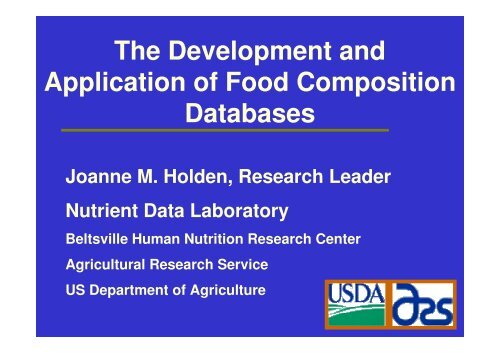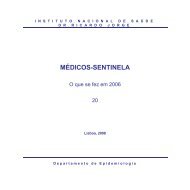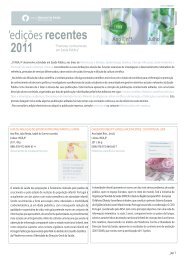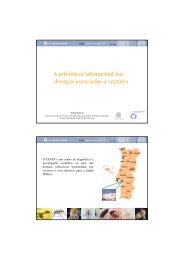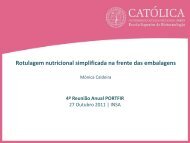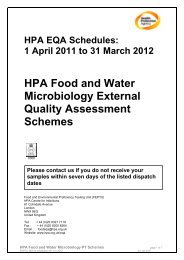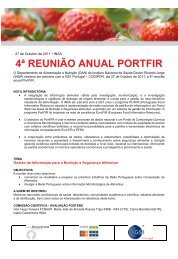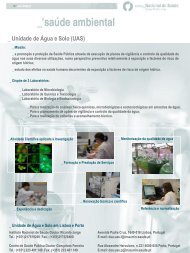The Development and Application of Food Composition Databases
The Development and Application of Food Composition Databases
The Development and Application of Food Composition Databases
You also want an ePaper? Increase the reach of your titles
YUMPU automatically turns print PDFs into web optimized ePapers that Google loves.
<strong>The</strong> <strong>Development</strong> <strong>and</strong><br />
<strong>Application</strong> <strong>of</strong> <strong>Food</strong> <strong>Composition</strong><br />
<strong>Databases</strong><br />
Joanne M. Holden, Research Leader<br />
Nutrient Data Laboratory<br />
Beltsville Human Nutrition Research Center<br />
Agricultural Research Service<br />
US Department <strong>of</strong> Agriculture
A knowledge <strong>of</strong> the chemical<br />
composition <strong>of</strong> foods is the first<br />
essential in dietary treatment <strong>of</strong><br />
disease or in any quantitative<br />
study <strong>of</strong> human nutrition.<br />
-McCance & Widdowson, 1940
Chronic Health Conditions<br />
Cardiovascular disease <strong>and</strong> hypertension<br />
Cancer<br />
Obesity<br />
Diabetes<br />
Blindness <strong>and</strong> macular degeneration<br />
Immune response/ Autoimmune diseases<br />
Dementia <strong>and</strong> Alzheimer’s disease<br />
Other- Vitamin A, Iodine, Iron, etc.
Today’s Assumptions<br />
<strong>Food</strong> intake affects human health status<br />
<strong>Food</strong> intake can have positive or negative<br />
effects<br />
<strong>Food</strong>s change over time- a dynamic system<br />
<strong>Food</strong> composition is a multi-variate problem<br />
based on biological chemistry <strong>and</strong> derived<br />
through statistics<br />
<strong>Food</strong> components (e.g. nutrients) are<br />
biological variables <strong>and</strong> vary according to<br />
mathematical principles
Intake Assessment <strong>of</strong><br />
Dietary Components<br />
Supplement<br />
Intake<br />
<strong>Food</strong><br />
Intake<br />
Component<br />
Values<br />
Total<br />
Components<br />
Intake
<strong>Food</strong> <strong>Composition</strong> Database?<br />
• <strong>The</strong> “reference” source for food values<br />
• Foundation for other databases<br />
• Lists <strong>of</strong> foods, raw, processed <strong>and</strong><br />
prepared<br />
• Nutrient values/other components<br />
• Good documentation<br />
• One source or many sources<br />
• Analyzed <strong>and</strong>/or calculated values
USDA Flow <strong>of</strong> FCD Information<br />
Analytical Projects<br />
(NFNAP, USDA, FDA, etc.)<br />
Industry Data<br />
Data from<br />
Scientific<br />
Literature<br />
<strong>Food</strong> <strong>and</strong><br />
Nutrient<br />
Database for<br />
Dietary<br />
Surveys<br />
Database System<br />
Imputations Formulations<br />
Recipes Algorithms<br />
St<strong>and</strong>ard<br />
Reference<br />
(SR)<br />
Label<br />
Information<br />
Special Releases<br />
(Vitamin K, Carotenoids<br />
Flavonoids, Choline,<br />
Nutritive Fluoride)<br />
Value <strong>of</strong> <strong>Food</strong>s<br />
(printed)
USDA’s Nutrient Database<br />
for St<strong>and</strong>ard Reference (SR)<br />
7100 foods<br />
Values for up to 128 nutritional components<br />
Agricultural commodities, formulated foods<br />
Generic estimates for agricultural<br />
commodities, processed, <strong>and</strong> prepared<br />
fruits, vegetables, meats, poultry, grains<br />
Br<strong>and</strong>name <strong>and</strong> generic estimates for RTE<br />
cereals, selected fast foods, c<strong>and</strong>ies,<br />
beverages
Expansion <strong>of</strong> <strong>Composition</strong> <strong>Databases</strong><br />
Short Lists <strong>of</strong><br />
<strong>Food</strong>s<br />
& Values<br />
Special Interest<br />
<strong>Databases</strong><br />
Literature<br />
Analytical<br />
Reports<br />
<strong>Food</strong> Industry<br />
FFQ<br />
Nutrient<br />
Database for<br />
St<strong>and</strong>ard<br />
Reference<br />
7100<br />
<strong>Food</strong>s<br />
3000<br />
<strong>Food</strong>s<br />
Survey Nutrient<br />
Database (FNDDS)<br />
7000 “Recipe”<br />
<strong>Food</strong>s reported by<br />
Participants<br />
62 Components<br />
Yield & Nutrient<br />
Retention Factors<br />
All Cells Filled
What Do the Data Represent?<br />
Estimates <strong>of</strong> means or central tendency<br />
Nationally representative <strong>of</strong> food supply?<br />
Based on high quality analytical data<br />
Recognized algorithms for calculation <strong>and</strong><br />
estimation<br />
Other statistical parameters?
How Are FCD Used?<br />
To estimate population intake <strong>of</strong> nutrients<br />
To determine Dietary Reference Intake STDs<br />
To initiate diet planning<br />
To conduct clinical research<br />
To provide dietary guidance<br />
To provide nutrient data for food labels<br />
(i.e., the food ingredients or final foods)<br />
To support trade <strong>of</strong> commodities or products
<strong>Food</strong> <strong>Composition</strong> Data<br />
Inappropriate Uses<br />
To calculate the intake <strong>of</strong> individuals<br />
<br />
<br />
Use <strong>of</strong> outdated data for current foods<br />
Analysis <strong>of</strong> one convenience sample<br />
to represent national or regional<br />
composition<br />
“Borrow” data from sources with<br />
different food supply
Questions about <strong>Food</strong> <strong>and</strong> Health<br />
Are “our foods” declining in nutritive<br />
value since 1950? Since 1975?<br />
What is the intake <strong>of</strong> nutrient “X” in our<br />
children?<br />
What are the nutrient-nutrient<br />
interactions which affect “our” people?<br />
French paradox vs Mediterranean diet?
<strong>Food</strong> Supply is Dynamic<br />
<strong>Food</strong> formulations change over time<br />
More food is consumed away from<br />
home or as processed prepared food<br />
Sources <strong>of</strong> foods change<br />
Sources <strong>of</strong> ingredients change<br />
Cultivars <strong>and</strong> breeds may change<br />
AND…Methods change….
-Carotene in Broccoli<br />
Updated Values<br />
2500<br />
2000<br />
(mcg/100 g)<br />
1500<br />
1000<br />
500<br />
Car98<br />
NFNAP<br />
NFNAP<br />
0
<strong>Food</strong> Changes in the USA<br />
1998-Folic acid fortification <strong>of</strong> cereal grains a<br />
2006- Trans fatty acid labeling<br />
Changes in pr<strong>of</strong>ile <strong>of</strong> safflower oil<br />
New DRI definition “Retinol Activity<br />
Equivalents”<br />
New biological activity factors for Vitamin E<br />
“Enhancement” <strong>of</strong> fresh pork <strong>and</strong> chicken<br />
cuts<br />
Introduction <strong>of</strong> the MDIII pineapple cultivarhigher<br />
vitamin C
Nutrient Distribution <strong>and</strong> Bias<br />
Type 1<br />
Type 2<br />
x<br />
x
Values for Fortified <strong>Food</strong>s<br />
Too high? Too low? Too variable?<br />
Folic acid, Vitamin D in milk, cereal grains<br />
Use <strong>of</strong> Fortification limit for FCDB value?<br />
Form <strong>of</strong> the nutrient used: all-rac a-<br />
tocopherol vs RRR-form<br />
Shift to processed foods: Use <strong>of</strong> fortified<br />
ingredients in processed foods? Iodized<br />
salt? Vit D fortified milk?<br />
Accepted bioactivity <strong>of</strong> nutrient forms<br />
Use <strong>of</strong> fortified foods as part <strong>of</strong> national food<br />
guidance plan
Fluoride variability in municipal water<br />
40<br />
35<br />
30<br />
Number<br />
<strong>of</strong><br />
samples<br />
25<br />
20<br />
15<br />
10<br />
5<br />
0<br />
0 20 40 60 80 100 120 140 160 180 200<br />
0 0.2 0.4 0.6 0.8 1.0 1.2 1.4 1.6 1.8 2.0<br />
Fluoridated<br />
Non-Fluoridated<br />
Mg/100 g<br />
ppm
Vitamin D Fortification <strong>of</strong> Milks<br />
2003 Grade “A” Pasteurized<br />
USDA Milk Ordinance<br />
Label Claim: 400 IU/quart ( or liter)<br />
Acceptable range for vitamin D is<br />
100 – 150% <strong>of</strong> label claim = 400 – 600 IU/qt
Vitamin D in New York Milk Samples 1 1997 -<br />
2000<br />
200<br />
175<br />
150<br />
Number <strong>of</strong> samples<br />
125<br />
100<br />
75<br />
50<br />
25<br />
0<br />
680<br />
Vitamin D, IU/Qt<br />
1<br />
Murphy, Whited, Rosenberry, Hammond, B<strong>and</strong>ler <strong>and</strong> Boor (2001) J. Dairy Sci. 84:2813-2820.
Enhancement <strong>of</strong> Fresh Pork <strong>and</strong><br />
Chicken…<br />
Meats are injected with solutions <strong>of</strong> sodium<br />
phosphates <strong>and</strong> other chemicals<br />
Permitted level is approximately 10-15%,<br />
by weight<br />
Appearance <strong>of</strong> meat is not altered<br />
Labeling is not adequate for consumer<br />
Sodium increases from 65 mg to >250<br />
mg/100g
Industry Changes Safflower Oil<br />
Pr<strong>of</strong>ile<br />
SFA<br />
MUFA<br />
PUFA<br />
NDB.ID.no<br />
Date<br />
High Linoleic<br />
Acid (gm /100g)<br />
9.1<br />
12.1<br />
74.5<br />
04510<br />
1990<br />
High Oleic Acid<br />
(gm/100g)<br />
6.2<br />
74.6<br />
14.4<br />
04511<br />
2000
DRI Panels Change Nutrient<br />
Definitions…<br />
Retinol activity equivalents replace earlier<br />
“retinol equivalents”<br />
New factors for conversion <strong>of</strong> beta- <strong>and</strong><br />
alpha-carotene to retinol are approved<br />
Alpha-tocopherol equivalents are replaced<br />
by mg <strong>of</strong> alpha-tocopherol<br />
All-rac alpha tocopherol is designated at<br />
lower activity than RRR-alpha tocopherol<br />
Folic acid is given higher activity than folate
Challenges for <strong>Databases</strong><br />
Updating food composition data<br />
Providing data for new components<br />
Support <strong>of</strong> the DRI’s<br />
Values for new <strong>and</strong> fortified products<br />
Harmonization with international policy<br />
Monitoring laboratory performance<br />
Assessing variability in nutrient data from<br />
labs
Harmonization with Int’l <strong>Databases</strong><br />
<strong>Development</strong> <strong>and</strong> application <strong>of</strong><br />
nutrient factors (nitrogen, energy)<br />
Systematic food description<br />
Evaluation <strong>of</strong> the quality <strong>of</strong> data<br />
<strong>Application</strong> <strong>of</strong> chemical methods<br />
Use <strong>of</strong> analytical quality control<br />
FAO-UNU-INFOODS
Setting Priorities…<br />
<strong>Food</strong> <strong>Composition</strong> Studies<br />
What are the major public health problems?<br />
What are the “Key” foods in the diet?<br />
Which foods are the primary sources <strong>of</strong><br />
nutrients?<br />
How good are the existing data?<br />
What methods are available?<br />
(e.g. analytical or calculation methods)<br />
What methods have changed?<br />
What resources (human, fiscal, technical) are<br />
available?
What Can Government Do?<br />
Recognize the need for continuous<br />
monitoring <strong>of</strong> nutrients in foods <strong>and</strong> the<br />
need to update<br />
Provide continuous funding <strong>and</strong> staff for<br />
maintaining a foundation or base for FCB<br />
Provide a scientific forum for research <strong>and</strong><br />
discussion<br />
Maintain a neutral <strong>and</strong> credible position<br />
based on scientific principles<br />
Increase visibility <strong>of</strong> FCDB
What Can the <strong>Food</strong> Industry Do?<br />
Serve as advocates for development <strong>and</strong> use<br />
<strong>of</strong> the National food composition data<br />
Support the development <strong>of</strong> FCDB with<br />
funding <strong>and</strong> scientific/ technical expertise<br />
Work as partners to plan <strong>and</strong> conduct new<br />
studies <strong>of</strong> food composition<br />
Contribute data for your food products
What is the Role <strong>of</strong> National Labs?<br />
To advocate for support for the FCDB.<br />
To provide technical information about<br />
the specific food groups for which data<br />
are needed.<br />
To collaborate with government to<br />
conduct rigorous <strong>and</strong> well-documented<br />
studies to update the FCDB for specific<br />
food groups
How Can Universities Help?<br />
Advocate for development <strong>and</strong> use <strong>of</strong> FCDB.<br />
Focus research on the development <strong>and</strong><br />
optimization <strong>of</strong> new state-<strong>of</strong>-the-art methods.<br />
<br />
Incorporate food composition modules into<br />
study proposals<br />
Train young pr<strong>of</strong>essionals (BS, MS, Ph.D.) in<br />
analytical techniques <strong>and</strong> their impact on<br />
food composition data<br />
Recognize the links between food<br />
composition research <strong>and</strong> biological<br />
science, mathematics, <strong>and</strong> economics
New Directions in Public Health<br />
Research indicates changes in bioavailability<br />
factors<br />
Hypotheses about new functions <strong>of</strong> “old”<br />
nutrients<br />
Long-term use <strong>of</strong> pharmaceutical drugs<br />
<strong>and</strong> possible food interactions<br />
Increased allergenicity to foods<br />
Increased longevity for the population<br />
Nutrition genetics<br />
New research on plant components in plants
What Will the Future Bring?<br />
Ability to analyze more foods <strong>and</strong><br />
compounds<br />
Greater electronic access to data within<br />
<strong>and</strong> across countries (e.g. EuroFIR)<br />
Greater transparency for data-more<br />
documentation for the data user<br />
Better nutrition research<br />
Better food choices by the people!
Nutrient Data on the Go!<br />
<br />
<br />
<br />
<br />
<br />
<br />
<br />
<br />
<br />
<br />
<br />
<br />
!"<br />
###$$!$%&''!<br />
<br />
#!()*$
Nutrient Data Laboratory, USDA<br />
Web Site:<br />
http://www.ars.usda.gov/nutrientdata
Muito Obrigada<br />
Perguntas? Questions?


